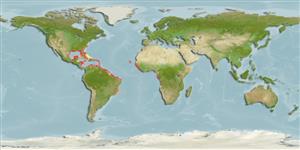Environment: milieu / climate zone / depth range / distribution range
Οικολογία
Θαλασσινό(ά) βενθικό(ς); εύρος βάθους 21 - 70 m (Ref. 2683), usually ? - 50 m (Ref. 26999). Subtropical; - 25°S
Western Atlantic: Bermuda and southern Florida, USA to Brazil. Lesser Antilles (Ref. 26938). Eastern Atlantic: Senegal to Angola (Ref. 4455). Doubtful record from the western Mediterranean (Ref. 13729).
Μέγεθος / Βάρος / Age
Maturity: Lm ? range ? - ? cm
Max length : 210 cm TL αρσενικό/απροσδιόριστο; (Ref. 26938); common length : 100.0 cm TL αρσενικό/απροσδιόριστο; (Ref. 5217)
Body pale, dark band across back of head (Ref. 26938).
Maximum depth from Ref. 126840. Lives in a permanent burrow, often in very shallow water. Heads protrude diagonally from the sand. Nocturnal. Feeds on octopus and fish (Ref. 5217). Bold and easily approached. Feared by fishers (Ref. 9710). Rarely consumed (Ref. 3795).
Life cycle and mating behavior
Γεννητική Ωρίμανση | Αναπαραγωγή | Γεννοβολία | Αβγά | Γονιμότητα | Προνύμφες
Böhlke, J.E., 1981. Ophichthidae. In W. Fischer, G. Bianchi and W.B. Scott (eds.) FAO species identification sheets for fishery purposes. Eastern Central Atlantic, (Fishing Areas 34, 47 (in part)), Vol. 3, [var. pag.]. FAO, Rome. (Ref. 3651)
IUCN Red List Status (Ref. 130435: Version 2024-2)
Threat to humans
Reports of ciguatera poisoning (Ref. 30911)
Human uses
αλιεία: χωρίς ενδιαφέρον; δόλωμα: usually
Εργαλεία
Special reports
Download XML
Διαδικτυακές πηγές
Estimates based on models
Preferred temperature (Ref.
123201): 19.2 - 27.5, mean 24.8 °C (based on 156 cells).
Phylogenetic diversity index (Ref.
82804): PD
50 = 0.5000 [Uniqueness, from 0.5 = low to 2.0 = high].
Bayesian length-weight: a=0.00091 (0.00039 - 0.00215), b=2.99 (2.79 - 3.19), in cm total length, based on LWR estimates for this (Sub)family-body shape (Ref.
93245).
Τροφικό Επίπεδο (Ref.
69278): 4.5 ±0.80 se; based on food items.
Ελαστικότητα (Ref.
120179): Πολύ χαμηλό, ελάχιστος χρόνος για διπλασιασμό πληθυσμού > 14 έτη (Preliminary K or Fecundity.).
Fishing Vulnerability (Ref.
59153): Very high vulnerability (90 of 100).
